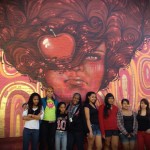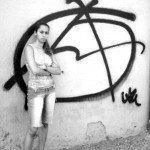By Nathan M. Walters, Senior Contributing Reporter
RIO DE JANEIRO, BRAZIL – In Portuguese the words “rua” (street) and “arte” (art) are both feminine, yet in the past women were all but absent from the street art movement in Rio. This is quickly changing, thanks in large part to one of Rio’s graffiti pioneers, Panmela Castro (aka Anarkia Boladona).

Graffiti and street art have long served as media for societies’ oppressed to deliver their message of empowerment. The early incarnations of the modern graffiti tradition were borne out of the disenfranchised communities in the Bronx in the late Seventies. Pichação, the controversial graffiti movement originating in São Paulo, likewise, was originally intended as a battle cry of Brazil’s have-nots.
Now, in Rio, thanks to the trailblazing work of Castro (and a handful of other women working in the pichação movement twenty years back) a new generation of women is making significant strides in a once male-dominated genre.
Castro states, “I started as a pichadora. My work today, with the feminist movement and painting on the street, is still influenced by the lessons I learned during that time. I wouldn’t be doing what I am doing today if it hadn’t been for pichação.” Her time painting as a pichadora not only influenced her painting style but, perhaps more importantly, created an empowered mindset that set the foundation for her extensive involvement with the feminist movement.
“I want to change women’s minds about their abilities, about our place in the world. This idea was formed while I was working with pichação. There is a misconceived notion that women shouldn’t do some of the things that men do. For example, some people are not willing to accept a woman scaling a building to paint a pichação. For me this made no sense. Women can be whatever they want.”

These thoughts lead Castro to develop Rede Nami – Feminist Urban Art Network, an organization that uses graffiti to promote the rights of women. The group has caught the attention of the world and earned Castro the much-earned respect and accolades from international organizations.
Castro was named by Newsweek, alongside Hillary Clinton and Lady Gaga, as one of the 150 Women That Shake the World. In March, Castro was awarded a DVF award, bestowed on courageous woman fighting for social change, one of five (including Oprah) to receive the annual award in 2012.
Rede Nami has helped forge a path for female empowerment. It provides a clear direction and end goal, but the struggle continues. Castro’s involvement in various activities (including the upcoming SlutWalk, intended to raise awareness about prejudiced views of rape victims, on May 26th in Copacabana) demonstrates the artist commitment to making a difference in the feminist movement.
Castro’s street work moves this agenda further in Rio and around the world. “I am traveling abroad more often these days, painting all over the world.” Castro’s street work is focused on depicting the female form in a way that comments on a particular theme (e.g., abortion, enslavement). The result is as powerful as it is beautiful, invoking both admiration and reflection in the observer.
Panmela is a role model and inspiration for both the street art and feminist movement in Brazil. Her contribution speaks to the positive social changes that can be achieved through public art.
















